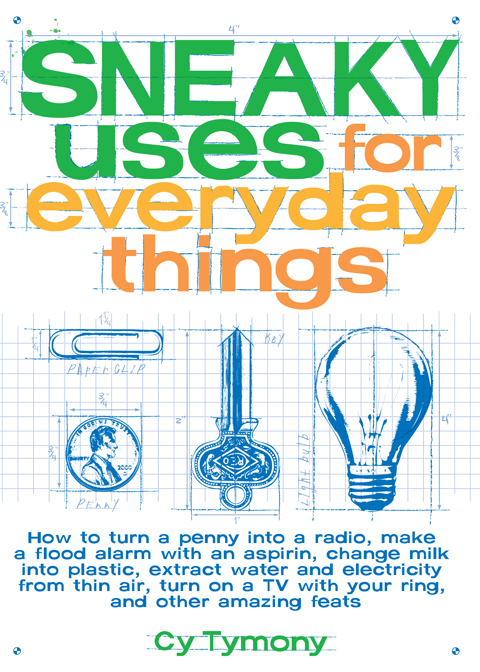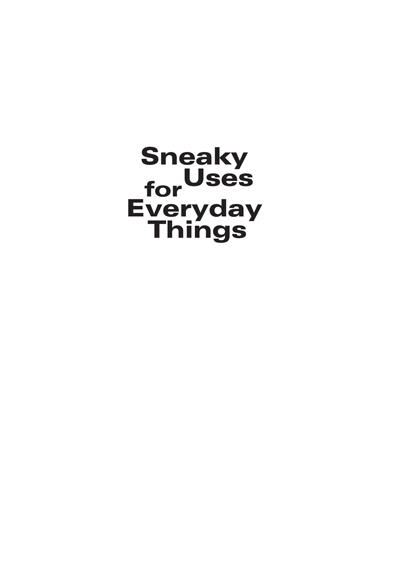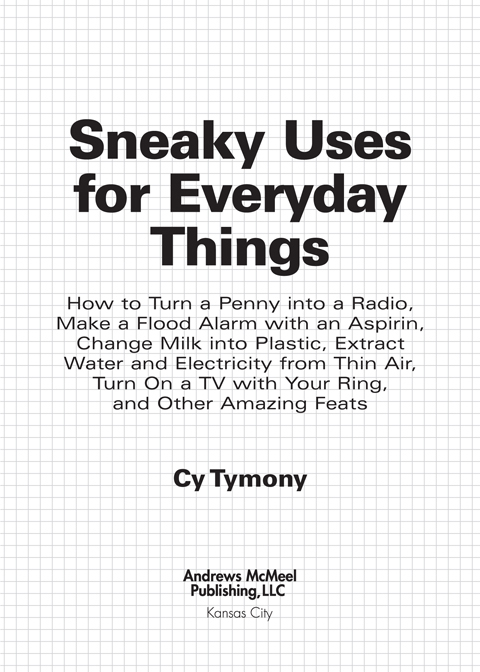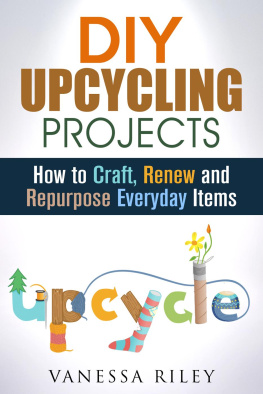


Sneaky Uses for Everyday Things
Copyright 2003 by Cy Tymony. All rights reserved. No part of this book may be used or reproduced in any manner whatsoever without written permission except in the case of reprints in the context of reviews.
Andrews McMeel Publishing, LLC
an Andrews McMeel Universal company
1130 Walnut Street, Kansas City, Missouri 64106
www.andrewsmcmeel.com
Library of Congress Control Number: 2003102991
Book design by Holly Camerlinck
Book composition by Kelly & Company, Lees Summit, Missouri
Attention: Schools and Businesses
Andrews McMeel books are available at quantity discounts with bulk purchase for educational, business, or sales promotional use. For information, please e-mail the Andrews McMeel Publishing Special Sales Department:
Disclaimer
This book is for the entertainment and edification of its readers. While reasonable care has been exercised with respect to its accuracy, the publisher and the author assume no responsibility for errors or omissions in its content. Nor do we assume liability for any damages resulting from use of the information presented here.
This book contains references to electrical safety that must be observed. Do not use AC power for any projects listed. Do not place or store magnets near such magnetically sensitive media as videotapes, audiotapes, or computer disks.
Disparities in materials and design methods and the application of components may cause your results to vary from those shown here. The publisher and the author disclaim any liability for injury that may result from the use, proper or improper, of the information contained in this book. We do not guarantee that the information contained herein is complete, safe, or acurate, nor should it be considered a substitute for your good judgment and common sense.
Nothing in this book should be construed or interpreted to infringe on the rights of other persons or to violate criminal statutes. We urge you to obey all laws and respect all rights, including property rights, of others.
Contents
Acknowledgments
Special thanks go to my agent, Sheree Bykofsky, for her enthusiastic encouragement and for believing in this book from the start. I am also appreciative of the assistance provided by Janet Rosen and Megan Buckley at her agency.
I wish to thank Jennifer Fox, my editor at Andrews McMeel, and copy editor, Janet Baker, for their invaluable work.
A warm thank-you goes to Bill Melzer for insights and opinions that helped shape this book.
I am also grateful for the project evaluation assistance provided by Jerry Anderson, Isaac English, Carlos Daza, Sybil Smith, and Serrenity Smith.
And I hope the following is adequate to show my invaluable appreciation and love for Cloise Shaw. Thanks, Mom. I love you.
Introduction
Life... is what we make it.
William James
Y ou dont have to be 007 to adapt unique gadgets, secure a room from intruders, or get the upper hand over aggressors. Anyone can learn how to become a real-life MacGyver in minutes, using nothing but a few hodgepodge items fate has put at our disposal. Sometimes you have to be sneaky.
Sure, it never hurts to have the smarts of Einstein or the strength of Superman, but theyre not necessary with Sneaky Uses for Everyday Things . When life puts us in a bind, the best solution is frequently not the obvious one. Itll be the sneaky one.
Solutions to a dilemma can come from the most unlikely sources:
A motorist stranded with a bad heater-valve gasket made a new one by cutting and shaping the tongue from an old track shoe. It worked well enough to get him home safely.
U.S. prisoners of war devised a stealthy makeshift radio receiver using nothing more than a razor blade, a pencil, and the wire fence of the prison camp as an antenna.
Convicts at Wisconsins Green Bay Correctional Institution scaled the prison walls using rope they braided from thousands of yards of dental floss.
On September 11, 2001, a window washer trapped in a Twin Towers elevator with five other passengers used his squeegee to pry open the doors and chisel through the wall to escape the inferno.
People rarely think about the common items and devices they use in everyday life. They think even less about adapting them to perform other functions. For lovers of self-reliance and gadgetry, Sneaky Uses for Everyday Things is an amazing assortment of more than forty fabulous build-it-yourself projects, security procedures, self-defense and survival strategies, unique gift ideas, and more.
Did you know that the coins in your pocket can generate electricity or receive radio signals? Want to know what household item can identify counterfeit paper currency? How to turn milk into plastic or glue? How to locate directions using the sun or the stars? How to make a compass without a magnet, extract water from thin air, use water to start a fire, or make a ring that can turn on your TV? Its all here. Even wire hangers and coffee-cream-container tops get their moment in the sun.
Sneaky Uses for Everyday Things does not include conventional projects found in most crafts and household hints books. Nor are instructions supplied for first aid, fishing, making a shelter, or spotting edible plants. The Resources section at the back includes lists of books and Web sites for obtaining science tricks, frugal facts, and camping information.
Sneaky Uses for Everyday Things avoids projects or procedures that require expensive or unusual materials not found in the average home. No special knowledge or tools are needed. Whether you like to conserve resources or like the idea of getting something for nothing, you can use the book as a practical tool, a fantasy escape, or a trivia guide; its up to you. Things will never appear the same again.
Lets start now. You can do more than you think!
Part I
Sneaky Tricks and Gimmicks
You too can do more with less! Many household items you use every day can perform other functions. Using nothing but a few supplies like paper clips, rubber bands, and refrigerator magnets, you can quickly make unique gadgets and gifts.
Want to know how to tell real paper currency from fake? How to make plastic and glue out of milk? Generate electricity from fruits?
If you have an insatiable curiosity for sneaky secrets of everyday things, look no further. The projects that follow can be made in no time. Start your entry into clever resourcefulness here.
The Fear of Small Sums:
Detect Counterfeit Bills
W hether its a hundred-dollar bill or a one, getting stuck with counterfeit money is a fear many of us have. In the United States in 2002, $43 million in fake currency was circulated. When counterfeit currency is seized, neither consumers nor companies are compensated for the loss. So what can we do about it? This project describes two methods to tell good currency from bad.
The first method is a careful visual inspection of the bill. Compare a suspect note with a genuine note of the same denomination and series. Look for the following telltale signs:
- The paper on a genuine bill has tiny red and blue fibers embedded in it. Counterfeit bills may have a few red and blue lines on them but they are printed on the surface and are not really embedded in the paper.








